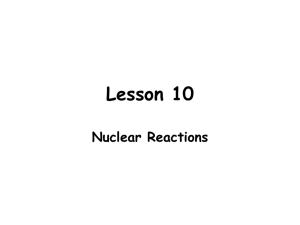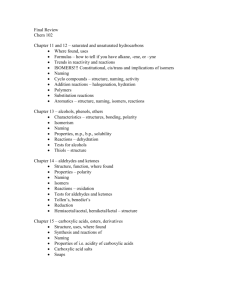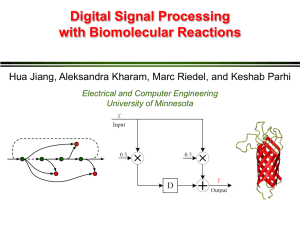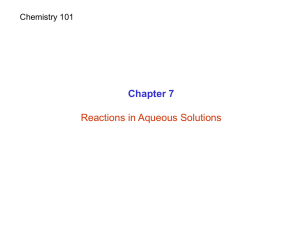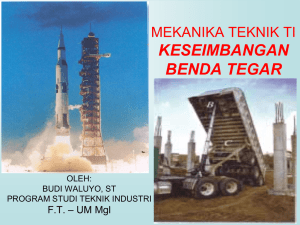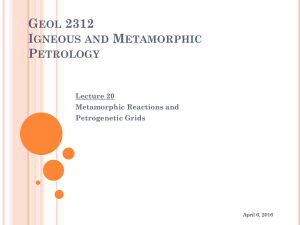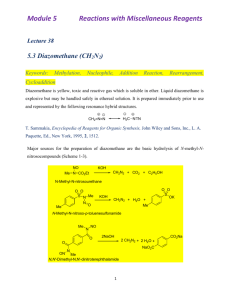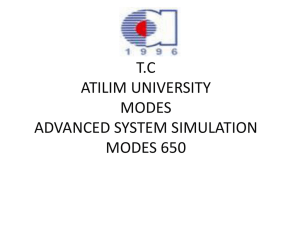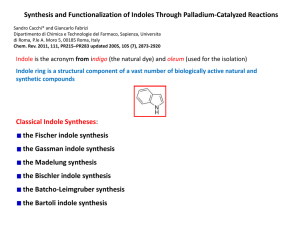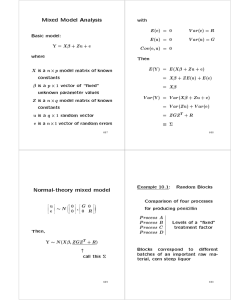Animated PowerPoint
advertisement
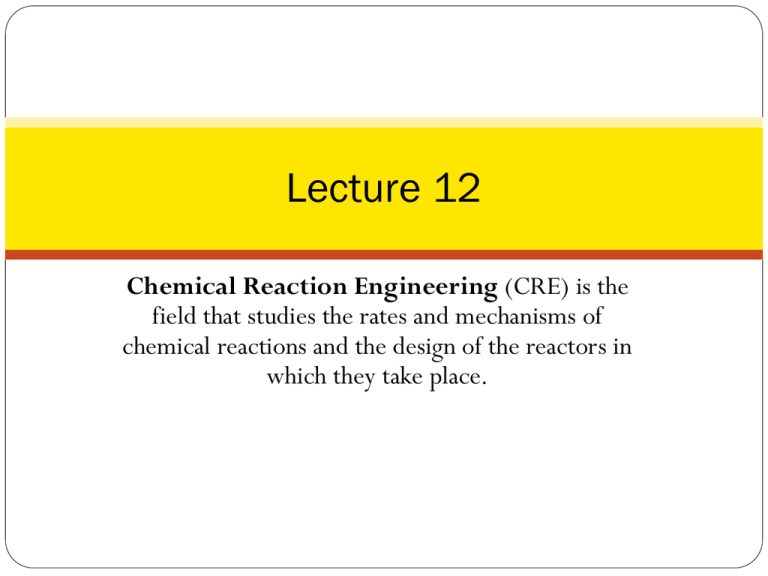
Lecture 12 Chemical Reaction Engineering (CRE) is the field that studies the rates and mechanisms of chemical reactions and the design of the reactors in which they take place. Lecture 12 – Tuesday 2/19/2013 Multiple Reactions A Selectivity and Yield Series Reactions Complex Reactions 2 A A kD kU D U B C A +B C+D A +C E 4 Types of Multiple Reactions Series: A→B→C Parallel: A→D A→U Independent: A→B C→D Complex: A + B →C + D A+C→E With multiple reactors, either molar flow or number of moles must be used (no conversion!) 3 Selectivity and Yield There are two types of selectivity and yield: Instantaneous and Overall. Instantaneous Selectivity Yield 4 S DU rD rU rD YD rA Overall F ~ S DU D FU ~ YD FD FA0 FA Selectivity and Yield k1 D Example: A B k2 A B U SD U Desired Product: rD k1CA2CB Undesired Product: rU k2CACB rD k1CA2CB k1 CA rU k2C ACB k2 To maximize the selectivity of D with respect to U run at high concentration of A and use PFR. 5 Gas Phase Multiple Reactions 6 Multiple Reactions A) Mole Balance of each and every species Flow dFA rA dV dFB rB dV 7 Batch dN A rAV dt dNB rBV dt Multiple Reactions B) Rates a) Rate Law for each reaction: b) Net Rates: r1 A k1 AC AC B r2 A k2 ACC C A rA riA r1A r2 A i 1 c) Relative Rates: 8 riA riB riC riD = = = -ai -bi ci di Multiple Reactions C) Stoichiometry Gas: FA P T0 C A CT 0 FA0 P0 T Liquid: CA FA 0 Example: 9 A→B→C (1) A → B k1 (2) B → C k2 Batch Series Reactions 1) Mole Balances dN A rA V dt dN B rB V dt dN C rC V dt V=V0 (constant batch) 10 dC A rA dt dC B rA dt dC C rA dt Batch Series Reactions 2) Rate Laws r1A k1A C A r1B k1B C B Laws rA r1A rB r1B r2 B r1A r1B 1 1 r2 B r2C 1 1 11 Net rates Relative rates Example: Batch Series Reactions A→B→C (1) A→B (2) B→C Ci A topt 1) Mole Balances V VO dC A rA dt 12 dC B rB dt B dC C rC dt C t Example: Batch Series Reactions 2) Rate Laws Laws: r1A k1CA r2 B k 2CB Relative: 13 r1A r1B 1 1 r2 B r2 C 1 1 Example: Batch Series Reactions 3) Combine Species A: dC A rA k1C A dt CA CA0 exp k1t Species B: dC B rB dt rB rB NET r1B r2B k1CA k 2CB dC B k 2 C B k1C A 0 exp k1t dt 14 Example: Batch Series Reactions Using the integrating factor, I .F . exp k 2 dt expk 2t d CB expk2t k C 1 dt A0 expk 2 k1 t at t = 0, CB=0 k1CA0 éëexp ( -k1t ) - exp ( -k2t )ùû CB = k2 - k1 CC C A 0 C A C B 15 C A0 CC k 2 1 e k1t k1 1 e k2t k 2 k1 Example: CSTR Series Reactions ABC What is the optimal ? 1) Mole Balances A: FA0 FA rAV 0 C A0 v0 C A v0 rAV 0 CA0 CA rA 0 B: 0 v0 C B rBV 0 C B rB 0 16 Example: CSTR Series Reactions ABC 2) Rate Laws Laws: r1A k1CA r2 B k 2CB Relative: Net: r1A r1B 1 1 r2 B r2 C 1 1 rA r1 A 0 k1C A rB r1 A r2 B k1C A k2CB 17 Example: CSTR Series Reactions ABC 3) Combine CA 0 - CA - k1CAt = 0 CA 0 CA = 1+ k1t -CB + ( k1CA - k 2CB )t = 0 18 k1CAt CB = 1+ k2t k1CA 0t CB = (1+ k2t )(1+ k1t ) Example: CSTR Series Reactions ABC Find that gives maximum concentration of B k1C A0 CB 1 k2 1 k1 max dCB 0 d 19 1 k1k2 20 End of Lecture 12 21 Supplementary Slides 22 Blood Coagulation 23 24 Notations 25 Notations 26 Mole Balances 27 Mole Balances 28 Mole Balances 29 Results 30 Blood Coagulation Many metabolic reactions involve a large number of sequential reactions, such as those that occur in the coagulation of blood. Cut → Blood → Clotting Figure A. Normal Clot Coagulation of blood 31 (picture courtesy of: Mebs, Venomous and Poisonous Animals, Medpharm, Stugart 2002, Page 305) Schematic of Blood Coagulation 32 Cut A+B C D E F 33 Clot
